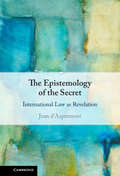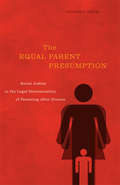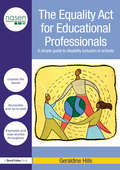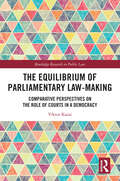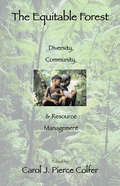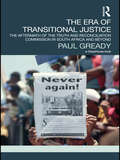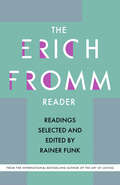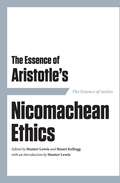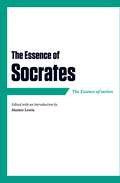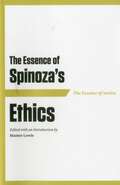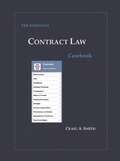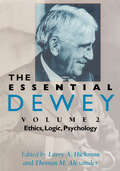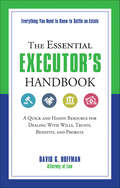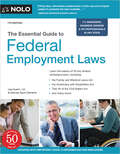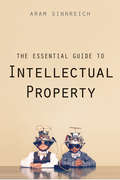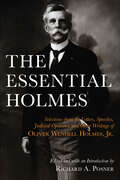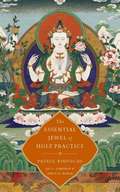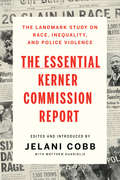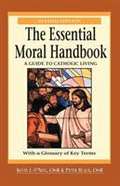- Table View
- List View
The Epistemology of the Secret: International Law as Revelation
by Jean d'AspremontIn this groundbreaking work, Jean d'Aspremont undertakes the first study of the epistemology of the secret of international law, which is a specific intellectual posture whereby international law is considered to be replete with secrets that international lawyers ought to reveal. In addition to arguing that the epistemology of the secret of international law is everywhere at work in international legal thought and practice, d'Aspremont demonstrates why this posture must be scrutinized, given how much it enables certain sayings, thoughts, perceptions and actions while simultaneously disabling others, making it complicit with the worst forms of capitalism, colonialism, racism, bourgeois ideology, phallocentrism, virilism and masculinism. This book should be read by anyone interested in how international law came to do what it does and why it must be rethought.
The Equal Parent Presumption
by Edward KrukIn custody battles over the children of separated parents, the prevailing standard of evaluating what is in the "best interests of the child" has been scrutinized because of the discretionary nature of what is "best" and because of the bias in favour of the child residing in one "primary residence." In response, a consensus is beginning to emerge that it is vitally important that children maintain meaningful relationships with both parents after divorce. In The Equal Parenting Presumption, Edward Kruk proposes a child-focused approach based on a standard that considers the best interests of the child from the perspective of the child and a responsibility-to-needs orientation to social justice for children and families. Challenging previous research and received ideas, Kruk presents an evidence-based framework of equal parental responsibility as the most effective means of ensuring the protection of family relationships following divorce, and shielding children from ongoing parental conflict and family violence. The existing system of determining parental rights and responsibilities is harming families. The Equal Parenting Presumption addresses a major barrier to the principle of gender equality in parenting after divorce, and proposes a viable alternative to sole custody in the form of a legal presumption of shared and equal parenting.
The Equal Parent Presumption: Social Justice in the Legal Determination of Parenting after Divorce
by Edward KrukIn custody battles over the children of separated parents, the prevailing standard of evaluating what is in the "best interests of the child" has been scrutinized because of the discretionary nature of what is "best" and because of the bias in favour of the child residing in one "primary residence." In response, a consensus is beginning to emerge that it is vitally important that children maintain meaningful relationships with both parents after divorce. In The Equal Parent Presumption, Edward Kruk proposes a child-focused approach based on a standard that considers the best interests of the child from the perspective of the child and a responsibility-to-needs orientation to social justice for children and families. Challenging previous research and received ideas, Kruk presents an evidence-based framework of equal parental responsibility as the most effective means of ensuring the protection of family relationships following divorce, and shielding children from ongoing parental conflict and family violence. The existing system of determining parental rights and responsibilities is harming families. The Equal Parent Presumption addresses a major barrier to the principle of gender equality in parenting after divorce, and proposes a viable alternative to sole custody in the form of a legal presumption of shared and equal parenting.
The Equality Act for Educational Professionals: A simple guide to disability inclusion in schools (nasen spotlight)
by Geraldine Hills"A definite must for SENCOS." -- Urmston Junior School "A good insight into process of tribunal and what the Equality Act means." -- Team Leader, St Paul's CE Primary School 'A much needed resource in supporting schools, centres, day nurseries and community childcare provision to understand the complexity of the issues surrounding SEN... A valuable tool.’ -- Gerri Ross – Head of Old Moat Sure Start Children’s Centre, UK "Straightforward and easily accessible...I would recommend this book to undergraduates and professionals alike who have an interest in ensuring that the rights of disabled children are upheld." -- Dr Craig Blyth, School of Education, University of Manchester, UK Under the Equality Act (2010), all schools and service providers have a legal obligation to make provision for disabled pupils, staff and school users. If you’re feeling confused and concerned about the content and implications of the Disability Duty Act (1995) and the more recently released Equality Act (2010), and how it affects your setting, this essential book will help you unpick the issues in a user-friendly and easily accessible way. This highly practical resource: explains the main parts of Equality Act (2010) as it affects disability in a way that will encourage all members of staff within a school to feel confident that they are correctly implementing its requirements; discusses ‘reasonable adjustments’ and ‘less favourable treatment’ which are at the heart of the legislation; shows how ‘less favourable treatment’ and ‘reasonable adjustments’ apply to admissions, exclusions, handling of medicines and during school trips; uses examples and case studies throughout, and highlights the key factors for success in making reasonable adjustments; takes readers through the process of an alleged act of discrimination against the school, and how it may be resolved, up to and including the SEND tribunal process. The author brings a wealth of experience to this topic, both as a parent of a disabled child and as a trainer of professionals. She uses her unique insight to develop skills and awareness in anyone who follows her material, and shows through tried and tested concepts and methods, how schools and settings can avoid costly and stressful tribunals. Headteachers, teachers, SENCos, Sure Start Centre Managers and anyone who works in educational settings will find this book essential to their professional development and a fantastic source of support and help.
The Equality Machine: Harnessing Digital Technology for a Brighter, More Inclusive Future
by Orly LobelAN ECONOMIST BEST BOOK OF 2022 At a time when AI and digital platforms are under fire, Orly Lobel, a renowned tech policy scholar, defends technology as a powerful tool we can harness to achieve equality and a better future. Much has been written about the challenges tech presents to equality and democracy. But we can either criticize big data and automation or steer it to do better. Lobel makes a compelling argument that while we cannot stop technological development, we can direct its course according to our most fundamental values. With provocative insights in every chapter, Lobel masterfully shows that digital technology frequently has a comparative advantage over humans in detecting discrimination, correcting historical exclusions, subverting long-standing stereotypes, and addressing the world&’s thorniest problems: climate, poverty, injustice, literacy, accessibility, speech, health, and safety. Lobel's vivid examples—from labor markets to dating markets—provide powerful evidence for how we can harness technology for good. The book&’s incisive analysis and elegant storytelling will change the debate about technology and restore human agency over our values.
The Equilibrium of Parliamentary Law-making: Comparative Perspectives on the Role of Courts in a Democracy (Routledge Research in Public Law)
by Viktor KazaiThis book is a response to the dangers posed to constitutional democracy by the continuous growth of executive power and the simultaneous decline of parliaments’ role in policy formation. These phenomena are often manifested in the manipulation and even the violation of the rules of parliamentary law-making, called irregularities. If left without consequences, these irregularities can ultimately lead to the elimination of the procedural constraints imposed on the ruling political forces to prevent their arbitrary exercise of power. This work investigates the constitutional significance of the irregularities of parliamentary law-making and explores the role that courts play in the remedy of these flaws. The analysis is premised on the concept of equilibrium. This explanatory concept denotes an ideal state in which parliamentary law-making complies with the requirements of constitutionalism, and judicial review is conceptualized as a mechanism suitable to achieve this aim. The volume places the judicial review of the regulation and the practice of parliamentary law-making at its center and discusses all the relevant legal concepts, institutions, and doctrines. It combines theoretical analysis with case law-centered comparative research covering a large number of decisions delivered by apex courts operating in various jurisdictions. Due to this methodological choice, the book aims to simultaneously contribute to the scholarly discourse and provide useful information to practicing lawyers and policymakers working in the areas of constitutional law and politics and comparative law.
The Equitable Forest: Diversity, Community, and Resource Management
by Carol J. Pierce ColferWhile there continues to be refinement in defining and assessing sustainable management, there remains the urgent need for policies that create the conditions that support sustainability and can halt or slow destructive practices already underway. Carol Colfer and her contributors maintain that standardized solutions to forest problems from afar have failed to address both human and environmental needs. Such approaches, they argue, often neglect the knowledge that local stakeholders have accumulated over generations as forest managers and do not address issues involving the diversity and well-being of groups within communities. The contributors note that these problems persist despite clear evidence that equity and social relationships, including gender roles, are important factors in the ways that communities adapt to change and manage forest resources overall. The Equitable Forest offers an alternative to traditional, externally organized strategies for forest management. Termed adaptive collaborative management (ACM), the approach tries to better acknowledge the diversity, complexity, and unpredictability of human and natural systems. ACM works to strengthen local institutions and use the knowledge and capacity of groups in local communities to enhance the health and well-being of both forests and the people who live in and around them. The Equitable Forest provides a detailed explanation of the descriptive, analytical, and methodological tools of ACM, along with accounts of early stages of its implementation in tropical regions of Asia, Africa, and Latin America. Although the contributors make it clear that it is too soon to evaluate the efficacy of ACM, their work is supported by evidence that rural communities do make important contributions when involved in formal forest management; that management strategies are most effective when flexible and tailored to local contexts; and that efforts by outside governmental and nongovernmental organizations to support local management are feasible from the policymaking perspective, and desirable for their impact on human, economic, and environmental well-being.
The Era of Transitional Justice: The Aftermath of the Truth and Reconciliation Commission in South Africa and Beyond
by Paul GreadyFirst Published in 2011. Routledge is an imprint of Taylor & Francis, an informa company.
The Erich Fromm Reader: Readings Selected and Edited by Rainer Funk
by Erich Fromm&“Fromm crossed the boundaries of traditional disciplines to expound his view on the alienation of man in an increasingly technological world.&” —Newsweek Erich Fromm&’s basic idea was to look at the individual as a social being, and to look at society as an ensemble of many individuals who have not only mutual ideas and convictions based on a common practice of life, but also a shared psychic structure. With his concept of &“social character,&” Fromm created a new interdisciplinary thinking presented in this compendium.The Erich Fromm Reader exhibits the true genius of an original thinker in seeing the connections between overlapping knowledge from many different fields. Here, interdisciplinarity is not only a lip service but the impact of Erich Fromm&’s unique social psychological notion.
The Essence of Aristotle's Nicomachean Ethics
by Hunter Lewis & Stuart KelloggAxios Press&’s Essence of . . . series takes the greatest works ever written in the field of practical philosophy and pares them down to their essence. We select the best passages—the ones that are immediately relevant to us today, full of timeless wisdom and advice about the world and how best to live our lives—and leave behind the more obscure or less important bits. Our selections are not isolated: they flow together to create a seamless work that will capture your interest and attention from page one. And we provide useful notes and a solid introduction to the work. Aristotle&’s Nicomachean Ethics is widely considered one of the most important historical philosophical works. Indirectly it was critical in the development of all modern philosophy, not to mention European law and theology. One might say that Aristotle was really the first social scientist. Like Machiavelli, he closely observed how people actually behaved, but unlike Machiavelli, he did so for the purpose of teaching virtue. Moreover, Aristotle formulated a unique way of looking at the good life—one that requires us to look for a mean between extremes. The motto &“Moderation in all things&” is completely Aristotelian, though he would probably have added &“. . . including moderation!&”Now with linking endnotes and index.
The Essence of Socrates
by Hunter LewisSocrates is important to us for many reasons. First, he recognized the value of logic and showed us how to use it to discover truth. Second, he led an exemplary and courageous life which cannot fail to inspire anyone who reads about it. His calm and eloquent defense of himself during the final trial for heresy, which ended in his condemnation and execution, are among the most famous passages in world literature. No one, apart from the great religious teachers, has had a more profound impact on human thought. Socrates himself wrote nothing. Fortunately his pupils Plato and Xenophon recorded his sayings for posterity. Indeed the connection between Socrates and Plato is so close that this little book could alternatively been titled The Essence of Plato. The latter&’s philosophical treatises did not survive, so that all that remains to us is the Dialogues which mostly recount the life of Socrates.Axios Press&’s Essence of . . . series takes the greatest works ever written in the field of practical philosophy and pares them down to their essence. We select the best passages—the ones that are immediately relevant to us today, full of timeless wisdom and advice about the world and how best to live our lives—and leave behind the more obscure or less important bits. Our selections are not isolated: they flow together to create a seamless work that will capture your interest and attention from page one. And we provide useful notes and a solid introduction to the work.
The Essence of Spinoza's Ethics
by Hunter LewisAxios&’s Essence of . . . Series takes the greatest works of practical philosophy and pares them down to their essence. Selected passages flow together to create a seamless work that will capture your interest from page one.Goethe: " [In his] Ethics ... , I found the serenity to calm my passions...."This new edition makes Spinoza's own words understandable by everyone.Now with linking index.
The Essential Contract Law Casebook
by Craig SmithThis textbook is designed for use in the first year Contracts course offered in U.S. law schools. It is written in a straightforward method that doesn't "hide the ball" while including a wide and representative collection of precedent setting cases in the field of Contract Law.
The Essential Debate on the Constitution: Federalist and Antifederalist Speeches and Writings
by Bernard Bailyn Robert AllisonReturn to the nation's founding to rediscover the dramatic original debates--on presidential power, religious liberty, foreign corruption, and more--that still shape our world todayWhen the Constitutional Convention adjourned on September 17, 1787, few Americans anticipated the document that emerged from its secret proceedings. James Madison, Alexander Hamilton, and the other framers had fashioned something radically new, a strong national government with broad powers. A fierce storm of argument soon broke out in advance of the state ratifying conventions that would decide the new plan's fate as Federalist supporters, Antifederalist opponents, and seekers of a middle ground praised, condemned, challenged, and analyzed the new Constitution. Here, in chronological order, are more than sixty newspaper articles, pamphlets, speeches, and private letters written or delivered during this ratification debate. Along with familiar figures such as Madison, Hamilton, and Patrick Henry, are dozens of lesser-known but equally engaged and passionate participants. The most famous writings of the period--especially the key Federalist essays--are placed in context alongside the arguments of insightful Antifederalists such as "Brutus" and the "Federal Farmer." Crucial issues quickly take center stage--the need for a Bill of Rights, the controversial compromises over slavery and the slave trade, whether religious tests should be imposed--and on questions that continue to engage and divide Americans: the relationship between the national government and the states, the dangers of unchecked presidential power and the remedy of impeachment, the proper role of the Supreme Court, fears of foreign and domestic corruption, and the persistent challenge of making representative government work in a large and diverse nation.
The Essential Dewey: Ethics, Logic, Psychology (The Essential Dewey #2)
by Larry A. Hickman and Thomas M. AlexanderThe second half of the insightful anthology of essays and book chapters from the American technical philosopher.In addition to being one of the greatest technical philosophers of the twentieth century, John Dewey (1859–1952) was an educational innovator, a Progressive Era reformer, and one of America’s last great public intellectuals. Dewey’s insights into the problems of public education, immigration, the prospects for democratic government, and the relation of religious faith to science are as fresh today as when they were first published. His penetrating treatments of the nature and function of philosophy, the ethical and aesthetic dimensions of life, and the role of inquiry in human experience are of increasing relevance at the turn of the twenty-first century.Based on the award-winning thirty-seven-volume critical edition of Dewey’s work, The Essential Dewey presents for the first time a collection of Dewey’s writings that is both manageable and comprehensive. The volume includes essays and book chapters that exhibit Dewey’s intellectual development over time; the selection represents his mature thinking on every major issue to which he turned his attention. Eleven part divisions cover: Dewey in Context; Reconstructing Philosophy; Evolutionary Naturalism; Pragmatic Metaphysics; Habit, Conduct, and Language; Meaning, Truth, and Inquiry; Valuation and Ethics; The Aims of Education; The Individual, the Community, and Democracy; Pragmatism and Culture: Science and Technology, Art and Religion; and Interpretations and Critiques. Taken as a whole, this collection provides unique access to Dewey’s understanding of the problems and prospects of human existence and of the philosophical enterprise.“In the course of his long life, Dewey wrote and published on myriad topics: certainly, and perhaps most importantly to him, on public education, but also—and extensively—on technical philosophy, including metaphysics, epistemology, logic, aesthetics, religion, science, ethics, and social philosophy. And though neglected by academic philosophers for a time, Dewey’s pragmatic orientation has recently proved influential in the thought of Quine, Putnam, and Rorty, among others. This two-volume collection of essays and book chapters, culled from an earlier 37-volume critical edition of his works, provides for the first time a publication of his writings that is both manageable and comprehensive.” —Library Journal
The Essential Executor's Handbook: A Quick and Handy Resource for Dealing With Wills, Trusts, Benefits, and Probate (The Essential Handbook)
by David HoffmanMany of you, regardless of your feelings on the matter, will eventually be appointed as executor of your parents’, spouse’s, or another’s estate.Just calling an attorney isn’t enough. Settling a decedent’s estate may require the combined expertise of accountants, appraisers, auctioneers, realtors, bankers, brokers, insurance companies, a myriad of bureaucrats, and, yes, even lawyers.Where do you start? How do you empty a house crammed with a lifetime’s worth of knick-knacks, bad art, and unopened mail? How do you deal with long-lost relatives who think you’re taking too long or charging too much? And how do you oversee those professionals who know so much more than you about the process?The Essential Executor’s Handbook not only explains the steps involved in settling an estate, but it shows you how to get all these professionals to do the work for you. You will learn everything you need to know about the basic laws and procedures involved; all the legal definitions you could possibly want; and why each professional is necessary, what they do, what they charge, and where to find them.No matter how little you know about law, accounting, and the rest, The Essential Executor’s Handbook will lead you by the hand through the settlement process.
The Essential Guide To Flatsharing, 2nd Edition: For sharers, lodgers and everyone renting out a room
by Matt Hutchinson Rupert HuntWhether you're looking for a flatshare or renting out a room The Essential Guide to Flatsharing has everything you need to know. If you're: * Renting out a spare room. * All about taking in a lodger; drawing contracts; the tax and financial issues; necessary preparation; advertising your room; and much more. * Looking for a flatshare. * Where to look; how to pick the best flatmates; how to keep your flatshare harmonious; how to avoid conflicts. * Finding a new flatmate. *How to advertise; picking the right person; dealing with money.
The Essential Guide to Federal Employment Laws
by Lisa Guerin Sachi ClementsWith The Essential Guide to Federal Employment Laws, you’ll learn the ins and outs of the most important employment laws, including: <P> who the law covers, what the law allows and prohibits, which federal agency enforces the law, and practical tips to avoid violations of the law. <P><P> Each chapter is dedicated to explaining and demystifying one federal employment law, including the: Americans with Disabilities Act, Family and Medical Leave Act, Fair Labor Standards Act, Immigration Reform and Control Act, National Labor Relations Act, Pregnancy Discrimination Act, Equal Pay Act and many more.
The Essential Guide to Intellectual Property
by Aram SinnreichA broad introduction to the changing roles of intellectual property within society Intellectual property is one of the most confusing—and widely used—dimensions of the law. By granting exclusive rights to publish, manufacture, copy, or distribute information and technology, IP laws shape our cultures, our industries, and our politics in countless ways, with consequences for everyone, including artists, inventors, entrepreneurs, and citizens at large. In this engaging, accessible study, Aram Sinnreich uncovers what’s behind current debates and what the future holds for copyrights, patents, and trademarks.
The Essential Guide to Internal Auditing
by K. H. PickettThe Second Edition of The Essential Guide to Internal Auditing is a condensed version of the Handbook of Internal Auditing, Third Edition. It shows internal auditors and students in the field how to understand the audit context and how this context fits into the wider corporate agenda. The new context is set firmly within the corporate governance, risk management, and internal control arena. The new edition includes expanded coverage on risk management and is updated throughout to reflect the new IIA standards and current practice advisories. It also includes many helpful models, practical guidance and checklists.
The Essential Holmes: Selections from the Letters, Speeches, Judicial Opinions, and Other Writings of Oliver Wendell Holmes, Jr.
by Oliver Wendell HolmesOliver Wendell Holmes, Jr., has been called the greatest jurist and legal scholar in the history of the English-speaking world. In this collection of his speeches, opinions, and letters, Richard Posner reveals the fullness of Holmes' achievements as judge, historian, philosopher, and master of English style. Thematically arranged, the volume covers a rich variety of subjects from aging and death to themes in politics, personalities, and law. Posner's substantial introduction firmly places this wealth of material in its proper biographical and historical context. "A first-rate prose stylist, [Holmes] was perhaps the most quotable of all judges, as this ably edited volume shows."—Washington Post Book World "Brilliantly edited, lucidly organized, and equipped with a compelling introduction by Judge Posner, [this book] is one of the finest single-volume samplers of any author's work I have seen. . . . Posner has fully captured the acrid tang of him in this masterly anthology."—Terry Teachout, National Review "Excellent. . . . A worthwhile contribution to current American political/legal discussions."—Library Journal "The best source for the reader who wants a first serious acquaintance with Holmes."—Thomas C. Grey, New York Review of Books
The Essential Holmes: Selections from the Letters, Speeches, Judicial Opinions, and Other Writings of Oliver Wendell Holmes, Jr.
by Oliver Wendell Holmes Jr.Oliver Wendell Holmes, Jr., has been called the greatest jurist and legal scholar in the history of the English-speaking world. In this collection of his speeches, opinions, and letters, Richard Posner reveals the fullness of Holmes' achievements as judge, historian, philosopher, and master of English style. Thematically arranged, the volume covers a rich variety of subjects from aging and death to themes in politics, personalities, and law. Posner's substantial introduction firmly places this wealth of material in its proper biographical and historical context. "A first-rate prose stylist, [Holmes] was perhaps the most quotable of all judges, as this ably edited volume shows."—Washington Post Book World "Brilliantly edited, lucidly organized, and equipped with a compelling introduction by Judge Posner, [this book] is one of the finest single-volume samplers of any author's work I have seen. . . . Posner has fully captured the acrid tang of him in this masterly anthology."—Terry Teachout, National Review "Excellent. . . . A worthwhile contribution to current American political/legal discussions."—Library Journal "The best source for the reader who wants a first serious acquaintance with Holmes."—Thomas C. Grey, New York Review of Books
The Essential Jewel of Holy Practice
by Jay L. Garfield Emily W. McRaeAn exquisite poem from one of Dzogchen’s greatest teachers.The Essential Jewel of Holy Practice is a vibrant philosophical and ethical poem by one of Tibet’s great spiritual masters. Patrul Rinpoche presents a complete view of the path of liberation from the perspectives of the Madhyamaka understanding of emptiness and the Mahayana ideal of compassionate care refracted through the Dzogchen perspective on experience, yielding a sophisticated philosophical approach to practice focusing on the cultivation of clear, open, luminous, empty awareness and of liberation leading to the transformation of one’s moral capacity and sensitivity. Patrul Rinpoche’s verses speak intimately and directly to the reader and inspire one to develop one’s mind for the sake of ethical perfection and liberation. The translators’ introduction provides a foundation for reading the poem and their commentary to the verses assists the reader in understanding Patrul Rinpoche’s allusions and technical terms.
The Essential Kerner Commission Report
by Jelani CobbRecognizing that an historic study of American racism and police violence should become part of today’s canon, Jelani Cobb contextualizes it for a new generation. The Kerner Commission Report, released a month before Martin Luther King Jr.’s 1968 assassination, is among a handful of government reports that reads like an illuminating history book—a dramatic, often shocking, exploration of systemic racism that transcends its time. Yet Columbia University professor and New Yorker correspondent Jelani Cobb argues that this prescient report, which examined more than a dozen urban uprisings between 1964 and 1967, has been woefully neglected. In an enlightening new introduction, Cobb reveals how these uprisings were used as political fodder by Republicans and demonstrates that this condensed edition of the Report should be essential reading at a moment when protest movements are challenging us to uproot racial injustice. A detailed examination of economic inequality, race, and policing, the Report has never been more relevant, and demonstrates to devastating effect that it is possible for us to be entirely cognizant of history and still tragically repeat it.
The Essential Moral Handbook: A Guide to Catholic Living
by Kevin J. O'Neil Peter BlackMoral theology is much more than a simple consideration of right and wrong. This book will help readers grasp the basic principles of moral theology in the Roman Catholic tradition and apply them to their own lives. This handbook leads to solid answers that respect human dignity, promote the rights of the individual, and stress the importance of personal responsibility. This book will provide valuable assistance to lay ministers, members of evangelical teams, parents mentoring their children in the basics of the faith, RCIA candidates, teachers, and those who want a review of moral issues in light of current events.
